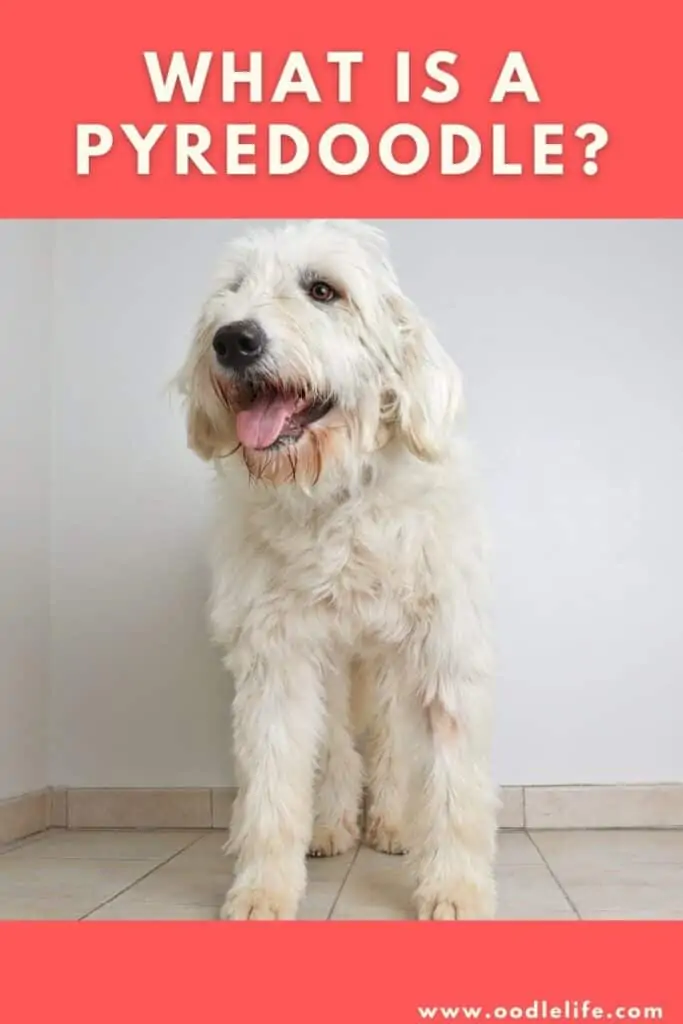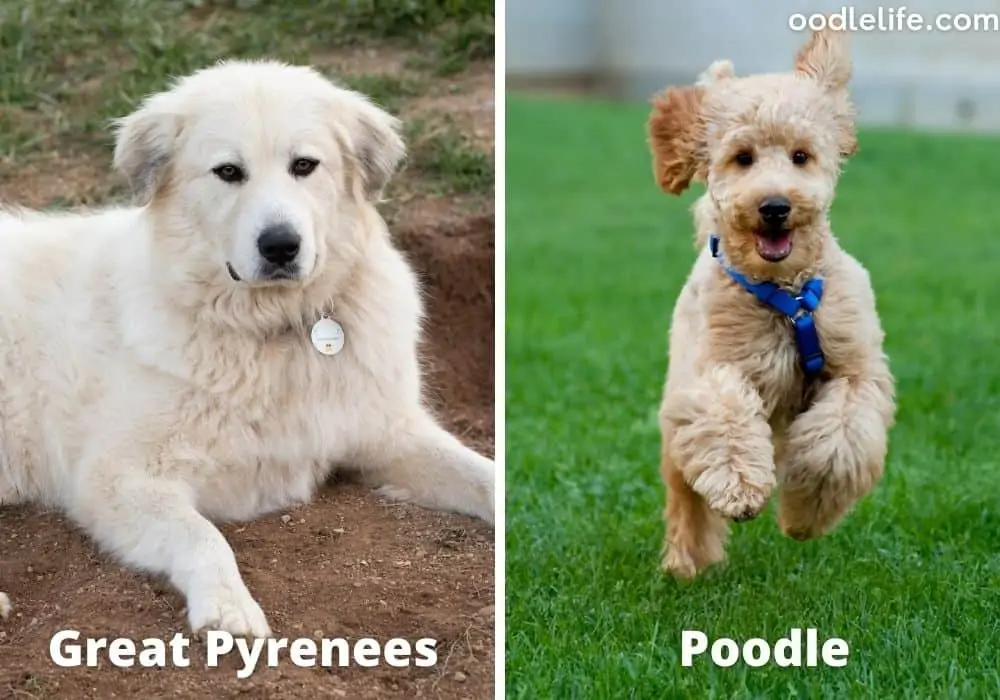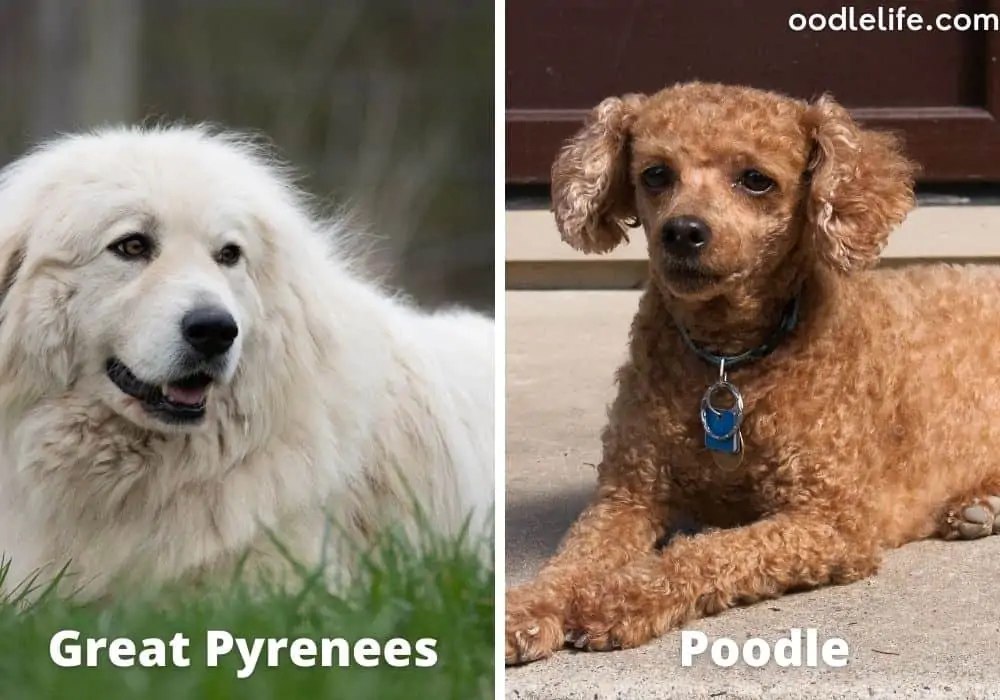What Is a Pyredoodle? [Pyredoodle Breed Guide]
In the world of designer dogs, it can sometimes be hard to keep all the adorable and varied mixes straight. While Poodles have lent their great genes to many of these designer mixes, we have to say that we’re quite partial to their lovable, loyal, fluffy offspring, the Pyredoodle.

These sweet and lovable dogs get the best of both worlds from their Great Pyrenees and Poodle parents. When considering which breed will make the best family pet or companion, you’d be missing out to not give the Pyredoodle a fair shake.
So today, we’re going to teach you everything you need to know about these family-friendly, gentle giant dogs who represent a perfect mix of the best Great Pyrenees and Poodle qualities.
History of the Pyredoodle
This wonderful designer mix has been around, at least since the 1980s. That was the decade when it first became popular to mix the Poodle breed with other dog breeds to produce new, designer breeds who would inherit the Poodle’s propensity for reduced shedding.
From that point on, many owners have extolled the benefits of these minimally shedding dogs along with their other good-natured qualities.
The Poodle breed itself goes much further back. The Standard Poodle breed, a part of the sporting class, dates back to 16th century Germany. The other half of the Pyredoodle breed, the Great Pyrenees in the working class, has its origins in 17th century France and Spain, where it was used as a countryside watchdog in charge of protecting herds of sheep.

Pyredoodle Size Guide
A Pyredoodle certainly isn’t a toy dog. The standard size is up to 80-100 pounds and up to 30 inches tall at the shoulder. You should expect a Pyredoodle puppy to become fully grown around 24 months at most.
Miniature Pyredoodles (crossbred with Toy Poodle or Mini Poodles) can be much smaller and as little as 40 pounds in full weight.
Of course, the size will vary for some dogs within this breed, as not all Pyredoodles are a clean-cut 50% Standard Poodle and 50% Great Pyrenees. Some can also differ in size due to smaller Poodle genes.
In all, there’s a great deal of variety within the breed when it comes to size, so it’s best to check with your veterinarian to make sure that, if you have a Pyredoodle puppy, he or she is growing into adulthood in a healthy and normal manner.
Temperament of the Pyredoodle

Because of its parent breeds, the Pyredoodle displays great temperament qualities inherited from both sides. Because of its herding and guarding instincts, this dog makes a wonderfully loyal and protective family dog. However, those herding instincts never border on aggression or the tendency to be high-strung, as can be the case with some other herding dogs.
From its Poodle side, the Pyredoodle tempers out its watchdog instincts with a very sweet personality that is well-inclined to watch over children. This dog is also highly intelligent and is motivated by a deep desire to please. Thus, a Pyredoodle can be pretty easily trained and is very well-behaved.
Ever the gentle giant, although these dogs can be intimidating for their size, they can be quite timid and shy themselves. This is why early socialization is important for helping them learn how to properly relate to other dogs and build healthy social skills.
Despite the size of the Pyredoodle, he’s a great dog for indoor living. Although he needs to get proper exercise, like all dogs, Pyredoodles are generally calm creatures content to hang around with the family and entertain them with silly hijinks.
Pyredoodle Social Needs
Even though this dog loves to lounge on the couch with the family, your Pyredoodle will need to be corralled into regular exercise. Providing a proper amount of walking time and mental stimulation every day will ensure that your Pyredoodle remains well behaved and calm when indoors (provided there is enough brain activities and distractions).
Due to this dog’s size, he can also be in danger of gaining weight quickly. So even though he’s great at making cute and pitiful faces, it’s best to ration out the treats for the sake of his health.
Pyredoodle Health and Lifespan
A healthy Pyredoodle can live a average of 10 to 12 years. Larger Pyredoodles can live short lifespans. Mini Pyredoodles can live longer.
There are a few health conditions that they can often be predisposed to.

One of these conditions is bloat, which occurs when your dog’s stomach fills with gas and then can twist painfully, and, sometimes, it can be fatal. Although Pyredoodles can have digestive issues, making sure to provide adequate time between feeding and exercise will help ensure that bloat doesn’t occur.
Canine Cushing’s disease and certain types of cancers can also be more common in Pyredoodles. However, health problems are much less common in designer dogs since they’re bred specifically to help mitigate genetically common health issues in both parents. Still, keeping up to date with vet visits, vaccinations, and spaying or neutering at the right time can all help ensure the healthiest life possible for your pooch.
Pyredoodle Shedding Coat and Grooming
Although the most common picture that comes to mind at the mention of a Pyredoodle is likely the shaggy white version, there are many different coat variations within the breed.

Length and Texture
Pyredoodles will be either long-haired or short-haired with either a straight or curly coat. Even when designing breeds, there are some variations to genetics, and the type of coat will determine which parent the dog takes after the most.
Pyredoodles Coat Colors
Besides coat texture and length, Pyredoodles have one of the widest color varieties of any type of breed. Although all of them have a black nose and rather floppy ears, they can come in a solid-colored coat or multi-colored coat in a variety of combinations of colors.
Among these colors are blue (which starts as black and becomes more faded with time), gray, silver (which looks like a more diluted gray), brown, apricot (which demonstrates a wide range of shades within this color itself), cream, black, white, and even cafe au lait (which is a type of light tan).
Just like Goldendoodles, red coated Pyredoodles tend to see their coat fade and lighten over time.
Grooming and Care
Regardless of the color of your Pyredoodle, they’ll need some grooming attention. Ones with thinner coats will need weekly brushing, while those with double coats need it daily. In terms of bathing, your Pyredoodle will only need it when necessary, as the natural oils of its coat will keep it appearing healthy.
Take note, though, that since Pyredoodles have floppy and furry ears, you’ll have to remain vigilant to make sure they stay cleaned out to prevent yeast overgrowth or ear infections. Your Pyredoodle’s health will also benefit from regular teeth brushing.
Optimal Diet for a Pyredoodle Poodle Mix
Because of the aforementioned possible health risks and the propensity for obesity, it’s important to pay attention to your Pyredoodle’s diet to make sure it’s balanced and properly suited to them.
The best type of feed for these dogs are ones high in protein and low in carbohydrates. This ensures that your Pyredoodle is well-fed with all the nutrients he needs without the worry that he’ll put on extra weight.
Because of their size, a large-sized kibble is also best for these dogs. It’s also best to feed them at specific meal times instead of allowing grazing. This helps not only to give your dog a sense of schedule and to keep them from overeating, but it also helps reduce the likelihood of bloat interfering with his exercise.
Establishing a proper diet, even at an early age, is important because it sets up good habits for your dog’s whole life. Many older dogs are prone to developing joint issues, and the Pyredoodle is no different. Keeping him in good shape and at a healthy weight will lessen the likelihood that his joints will wear down from bearing too much extra weight.

Who is a Pyredoodle Best For?
When looking for a larger dog well-suited to families with children and predominantly indoor living, you can’t get much better than a Pyredoodle. These are incredibly sweet, well-mannered, and calm—but entertaining—dogs who will give you a lifetime of loyalty and companionship.
Because of their heritage, they make a great addition to families with allergy concerns. However, be aware that, as is the case when adopting any puppy, Pyredoodle puppies can be a lot of work! Properly training and socializing these dogs at a young age is crucial for them to live a happy and well-adjusted life.
Suppose you have the time and ability to put a little extra effort into grooming, training, and a slight bit of preventative health care. In that case, the Pyredoodle will no doubt fit perfectly into your family and make a wonderful, loving companion for its whole life.
Consider Adopting a Pyredoodle
If the Pyredoodle sounds like the perfect dog for you, consider adoption before contacting a breeder. Even though the Pyredoodle is a designer dog, you would be surprised at the number of purebred and designer dogs that pass through human societies, shelters, and rescue organizations.
Like any of the rarer Oodle dogs – Pyredoodles are in limited supply. (Other rare Oodle dogs include Shepadoodle, Doxiepoo, the Peekapoo and Boxerdoodles).
Adopting a pet often comprises the best of both worlds, as you don’t have to worry about potty training and other intensive puppy-oriented responsibilities. Likewise, you’re providing a home for a pet that desperately needs one.
Consider contacting a breed-specializing rescue organization near your area. There are likely to be plenty of Pyredoodles who are well-deserving of a family and who are just waiting to become a perfect and loving part of yours!